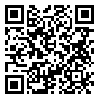1. Lewinsohn PM, Rohde P, Seeley JR, Klein DN. Axis II psychopathology as a function of Axis I disorders in childhood and adolescence. J Am Acad Child Adolesc Psychiatry. 1997;36(12):1752-9. [
DOI:10.1097/00004583-199712000-00024]
2. Cartwright-Hatton S, McNally D, White C, Verduyn C. Parenting skills training: an effective intervention for internalizing symptoms in younger children? J Child Adolesc Psychiatr Nurs. 2005;18(2):45-52. [
DOI:10.1111/j.1744-6171.2005.00014.x]
3. Larsson B, Fossum S, Clifford G, Drugli MB, Handega BH, Møorch WT. Treatment of oppositional defiant and conduct problems in young Norwegian children. Eur Child Adolesc Psychiatry. 2009;18(1):42-52. [
DOI:10.1007/s00787-008-0702-z]
4. Breslow RE, Klinger BI, Erickson BJ. The disruptive behavior disorders in the psychiatric emergency service. Gen Hosp Psychiatry. 1999;21(3):214-9. [
DOI:10.1016/S0163-8343(99)00006-7]
5. Blanchard EL. Constructs of the child behavior checklist that predict treatment outcome in children with oppositional defiant disorder. 2008.
6. Nelson-Gray RO. The relation between DSM-IV: Oppositional defiant disorder and conduct disorder: Finding from the great smoky maintains study. Journal Children Psychology Psychiatry. 2006. 43:39-50.
7. Kazdin AE, Marciano PL, Whitley MK. The therapeutic alliance in cognitive-behavioral treatment of children referred for oppositional, aggressive, and antisocial behavior. J Consult Clin Psychol. 2005;73(4):726-30. [
DOI:10.1037/0022-006X.73.4.726]
8. Pennington BF, Ozonoff S. Executive functions and developmental psychopathology. J Child Psychol Psychiatry. 1996;37(1):51-87. [
DOI:10.1111/j.1469-7610.1996.tb01380.x]
9. Markward MJ, Bride B. Oppositional defiant disorder and the need for family-centered practice in schools. Child Sch. 2001;23(2):73-83. [
DOI:10.1093/cs/23.2.73]
10. Schaefer CE. Play therapy for preschool children. American Psychological Association; 2010. [
DOI:10.1037/12060-000]
11. Michael Harris, Samuel Turner. Diagnostic Interview. Translator: Shamlo Reza mohammdi. Tehran, Rosh pub. 2007. (Persian) .
12. Serra-Pinheiro MA, Schmitz M, Mattos P, Souza I. Oppositional defiant disorder: a review of neurobiological and environmental correlates, comorbidities, treatment and prognosis. Rev Bras Psiquiatr. 2004;26(4):273-6. [
DOI:10.1590/S1516-44462004000400013]
13. RSanders M, Morawska A. Can Changing Parental Knowledge, Dysfunctional Expectations and Attributions, and Emotion Regulation Improve Outcomes for Children? Parent Ski. 2007.
14. Cetinkaya P, Erktin E. Assessment of metacognition and its relationship with reading comprehension, achievement, and aptitude. Bogazici Universitesi Egitim Derg. 2002;19(1):1-11.
15. Efklides A. Metacognition and affect: What can metacognitive experiences tell us about the learning process? Educ Res Rev. 2006;1(1):3-14. [
DOI:10.1016/j.edurev.2005.11.001]
16. Perfect TJ, Schwartz BL. Applied metacognition. Cambridge University Press; 2004.
17. Mohseni, N. Theory in developmental psychology. First edition, Tehran: Pardis Pub. 2004. (Persian) .
18. Wells A. Metacognitive therapy for anxiety and depression. Guilford press; 2011.
19. Alizadeh, H. Relationship between neuro - cognitive executive function by developmentals disorders. Journal of Cognitive Science,2007. 8 (4) ,70-51. (Persian) .
20. 20 Barkley RA. Attention-deficit hyperactivity disorder: A handbook for diagnosis and treatment. 2nd ed. Guilford Publications; 1998.
21. Locascio G, Mahone EM, Eason S, Cutting L. Executive dysfunction among children with reading comprehension deficits. J Learn Disabil. 2010. [
DOI:10.1177/0022219409355476]
22. Lauren PE. Relationship between primary neuropsychological deficits, executive funections, and social perception in nonverbal learning disabilities. [PhD. Thesis]. Widener University. 2004.
23. Gates LL. Executive Function and False Recall in Nonverbal Learning Disability. York University Toronto; 2009.
24. Rees CS, Van Koesveld KE. An open trial of group metacognitive therapy for obsessive-compulsive disorder. J Behav Ther Exp Psychiatry. 2008;39(4):451-8. [
DOI:10.1016/j.jbtep.2007.11.004]
25. Bahadori MJM, Kajbaf M, Faramarz S. The efficacy of cognitive therapy on cognitive beliefs and cognitive trust in social anxiety disorder patients. Journal of Clinical Psychology.
26. Asli azad M, Yarmohammadian B. The effect of training metacognition and perception of spatial relationship on the improvement of mathematical operation in children with mathematics learning disabilities. Journal of Clinical Psychology. 2012:4(2): 61-70. [Persian].
27. Son LK, Metcalfe J. Metacognitive and control strategies in study-time allocation. J Exp Psychol Learn Mem Cogn. 2000;26(1):204-221. [
DOI:10.1037/0278-7393.26.1.204]
28. Hoffman B, Spatariu A. The influence of self-efficacy and metacognitive prompting on math problem-solving efficiency. Contemp Educ Psychol. 2008;33(4):875-93. [
DOI:10.1016/j.cedpsych.2007.07.002]
29. Skitka LJ. Do the means justify the ends, or do the ends justify the means. Value Prot Model Justice. 2002;28: 452-61. [
DOI:10.1177/0146167202288003]
30. Schleifer LL, Dull RB. Metacognition and performance in the accounting classroom. Issues Account Educ. 2009;24(3):339-67. [
DOI:10.2308/iace.2009.24.3.339]
31. Zulkiply N, Kabit MR, Ghani KA. Metacognition: What roles does it play in students' academic performance? Int J Learn. 2008;15(11):97-105. [
DOI:10.18848/1447-9494/CGP/v15i11/45997]
32. Jenks, K. & Lieshout, E. Arithmetic Difficulties in children with Cerebral Palsy are Related to Executive Function and Working memory, Journal of Child Psychology and Psychiatry:Jul. 2009. vol. 50,lss. V, pp. 824. [
DOI:10.1111/j.1469-7610.2008.02031.x]
33. Diamond, A. Preschool children's, Performance in Cognitive function. , Journal Developmental Neurophysiology. 2000. vol. 28, pp. 689-729. [
DOI:10.1207/s15326942dn2802_7]
34. Blair, C. , Zela, D. & Greenberge, M. The Measurement of Executive Function in Early childhood. , J. Deuolopmental neuropsychological. 2005. vol. 28 (2) , pp. 561-571. [
DOI:10.1207/s15326942dn2802_1]
35. Gadow, K. D, Sparfkin, J. Child symptom inventories manual. Story brook, NY:Chechmate plus. 1994.
36. Grayson, P & Carlson, G. A. The utility of a DSM-III-R-based checklist in screening child psychiatric patients. Journal of the American Academy of Child and Adolescent Psychiatry. 1991. 30, 64-673. [
DOI:10.1097/00004583-199107000-00021]
37. Gadow, K. D, Sparfkin, J. Quick guide to using the youths inventory-4 screening kit. Stony brook, NY: Checkmate plus. 1997.
38. Ammerman, R. T. , Slomka, G. , Reigel, D. H. , Zapadka, M. E. & Kane, V. Neurocognitive and neurosurgical correlates of psychiatric symptomatology in spina bifida. In: Scientific Proceedings of the Annual Meeting of the American Academy of Child and Adolescent Psychiatry. 1997. 13,12.
39. Tavakoli, J. Epidemiological study of attention deficit disorders and behavior in school children Gonabad harassment. MS Thesis, University of Medical Sciences, Iran. 1997. (Persian)





